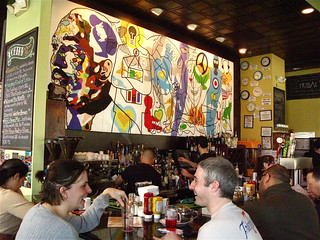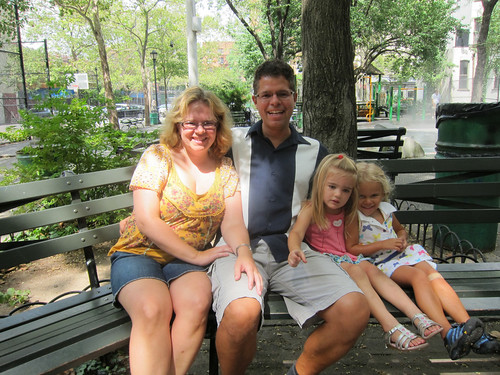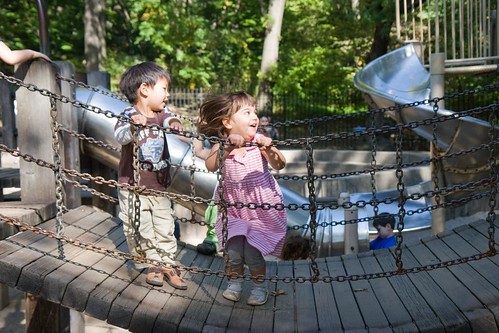Are we creating family-friendly cities? If not, shouldn't we be?

Posted January 15, 2014 at 1:30PM
As much as anyone, I have touted changing demographics in the US that show the growth of childless households as a portion of overall population. Given that families with kids are the traditional market for sprawling suburban subdivisions, this trend is seen by many, including yours truly, as helpful to our need to establish more compact development patterns that conserve land, reduce rates of driving and global warming emissions, and strengthen walkability.
Indeed, real estate analysts believe that, while there will be a continuing demand for homes with larger suburban lots, that portion of future demand can be met by current supply. The growth in the housing market will be for small-lot and multifamily housing, for which there is now a shortage compared to future demand projections.
So far, so good. But is there a fly in the ointment? The portion of families with kids may be smaller than in the past, but it is not insignificant. In our rush to promote higher-density urbanism, are we inadvertently creating child-free zones that are inhospitable to families with kids? And, if so, are we diminishing part of the cultural diversity that makes great cities?
 Aaron Renn, in an article published last week on his popular blog The Urbanophile, is troubled by the trend. He believes that many inner cities essentially lost the family market some time ago and now appeal mostly to a growing, but nonetheless limited, demographic of “singles, gays, and empty-nesters.” Aaron writes that, of the 61 municipalities in 2010 that had 300,000 or more people, urbanist exemplar San Francisco ranked “dead last” in percentage of children under 18 at 13.4 percent. “The bottom ten is heavily populated by an urbanist who’s who,” he continues, “including Seattle, Washington, Boston, Portland, and Minneapolis.”
Aaron Renn, in an article published last week on his popular blog The Urbanophile, is troubled by the trend. He believes that many inner cities essentially lost the family market some time ago and now appeal mostly to a growing, but nonetheless limited, demographic of “singles, gays, and empty-nesters.” Aaron writes that, of the 61 municipalities in 2010 that had 300,000 or more people, urbanist exemplar San Francisco ranked “dead last” in percentage of children under 18 at 13.4 percent. “The bottom ten is heavily populated by an urbanist who’s who,” he continues, “including Seattle, Washington, Boston, Portland, and Minneapolis.”
Here’s a chart of the bottom-rankers, their population of children, and the share of children in each city’s overall population:
|
Rank |
Municipality |
2010 |
|
1 |
San Francisco city, CA |
107,524 (13.4%) |
|
2 |
Seattle city, WA |
93,513 (15.4%) |
|
3 |
Pittsburgh city, PA |
49,799 (16.3%) |
|
4 |
Washington city, DC |
100,815 (16.8%) |
|
5 |
Boston city, MA |
103,710 (16.8%) |
|
6 |
Urban Honolulu CDP, HI |
58,727 (17.4%) |
|
7 |
Miami city, FL |
73,446 (18.4%) |
|
8 |
Portland city, OR |
111,523 (19.1%) |
|
9 |
Atlanta city, GA |
81,410 (19.4%) |
|
10 |
Minneapolis city, MN |
77,204 (20.2%) |
The national share of children in the US population (as of late 2012) is 24 percent, down two points from 1990, and expected to decline by another point by 2050, according to the Population Reference Bureau, a nonprofit research group in Washington that studies global and U.S. trends. Roughly a quarter of the population remains a statistically important segment, and a particularly important one given that kids represent our society’s future.
As it happens, Aaron isn’t the only one who has been thinking about the implications. In the revitalization chapter of my book People Habitat, I discussed a decline in kids in Washington, DC, where I live, even as the population as a whole has been growing (finally, after decades of decline).  According to Jonathan O’Connell in the Washington Post, a census analysis published in 2011 showed that almost all of the city’s population increase since 2000 can be accounted for by an increase in residents between 20 and 35 years old. The number of children younger than 15 actually dropped by a fifth.
According to Jonathan O’Connell in the Washington Post, a census analysis published in 2011 showed that almost all of the city’s population increase since 2000 can be accounted for by an increase in residents between 20 and 35 years old. The number of children younger than 15 actually dropped by a fifth.
What happens when these 20- to 35-year-olds outgrow their one-bedroom condos? Is it good for the city to lose them to the suburbs?
In his article, Aaron takes the question a step further. What if the overwhelming majority of kids left in the city are from families who have no choices about where to live, and are dependent on government subsidy for their well-being? Aaron writes:
“My impression is that a large percentage of the urban stories [in today’s urbanist media] that are about children involve hand-wringing over the need for social service spending. Notwithstanding the real need for social services, a life of public housing, food stamps, and Medicaid is not aspirational. The fact that so many children in the city are in fact those whose parents are too poor to get out and who need extensive public support just to survive is not something to be celebrated.
“If we expect cities to be part of the answer to the problem of climate change, the financial unsustainability of sprawl, or anything else, then it has to be a place where children can be raised to thrive in the world . . . This doesn’t mean necessarily junking the urbanist agenda, but it does mean building a bigger tent and not overly obsessing the needs of niche market segments.”
Intuitively, I agree.
A big part of the answer, of course, lies with improving the unfortunate state of urban education in the US. My very imperfect sense is that some school systems, including Washington’s, are indeed making progress, but at a snail’s pace. I wish I were qualified to make suggestions for better city schools, because there are environmental consequences when perceptions about public schools send conscientious parents out of the city.
But perhaps some answers lie in the character of the built environment, too. Should we diversify our urban housing stock to include larger as well as smaller homes, to include playgrounds as well as trendy espresso bars? What about more kid-friendly restaurants?
We definitely should include more parks and other green space concurrent with dense development; while highly urban districts are unlikely to include large private yards, we should take advantage of vacant lots and other opportunities to integrate more shared green space into dense residential neighborhoods. This brings benefits in addition to accommodating families, such as absorption of stormwater and reducing the impact of urban heat islands. As I implied in my last post, I think smart growth and urbanist advocates sometimes underestimate the power of nature to soothe some of the harder edges of city living.
These things would be a start. What ideas do readers have for cultivating more kids in the city? I know that some parents love cities so much that they and their kids will stay, even if they have options and even if they have to put up with some urban hassles. But some of these statistics suggest that, at present, there may not be enough of them. If we’re as committed to diversity as we like to say, shouldn’t that include children?
Move your cursor over the images for credit information.
Kaid Benfield writes about community, development, and the environment on Switchboard and in the national media. Kaid’s new book is People Habitat: 25 Ways to Think About Greener, Healthier Cities, available from booksellers nationwide.

